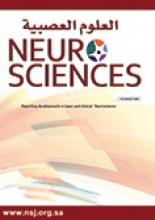Article Figures & Data
Tables
Characteristics n (%) Age <20 years 46 (14.7) 20-39 161 (51.4) 40-59 84 (26.8) 60-80 22 (7) Gender Male 154 (49.2) Female 159 (50.8) Education Never attended school 27 (8.6) Secondary school and lower 113 (36.1) College and above 173 (55.3) Marital status Married 181 (57.8) Single 109 (34.8) Divorced 8 (2.6) Widow 15 (4.8) - Table 2
Knowledge of stroke warning symptoms as reported by participants before and after intervention.
Statements Pre Intervention (n = 313) Post Intervention(n = 313) P-value Concept of stroke pre & post intervention n (%) <0.001 Sudden loss of brain functions because of disturbance in blood flow to the brain 199(63.6) 304(97.1) Collection of fluids within the brain 37(11.8) 5(1.6) Abnormal growth of tissues within the brain 15(4.8) 1(0.3) I don’t know 62(19.8) 3(1) Do you know any stroke Warning Symptoms? Yes 109(34.8) 308(98.4) No 204(65.2) 5(1.6) If Yes 109(34.8) 308 (98.4) Face dropping/ facial asymmetry 20(18.3) 267(86.6) <0.001 Arm/ one side of the body weakness or Paralysis 68(62.3) 292(94.8) <0.001 Speech/reading difficulty 31(28.4) 278(90.2) <0.001 Numbness/dead sensation 22(20.1) 83(26.9) 0.162 Walking / balance difficulties 4(3.6) 32(10.3) 0.031 Visual difficulty/ loss of vision 6(5.5) 26(8.4) 0.322 Fainting/ loss of consciousness 25(22.9) 25(8.1) <0.001 Sudden severe headache 12(11) 64(20.7) 0.023 Dizziness 7(6.4) 18(5.8) 0.827 Temporary loss of memory 4(3.6) 5(1.6) 0.206 Seizures 3(2.7) 4(1.2) 0.312 Shortness of breath/Chest Pain 4(3.6) 0(0) - Migraine 1(0.3) 0(0) - Significant at p-value<0.05 Knowledge of stroke risk factors as reported by participants before and after intervention.
Pre Intervention (n = 313) Post Intervention (n = 313) P-value n (%) Do you know any stroke Risk factors? Yes 130(41.5) 296(94.6) No 183(58.5) 17(5.4) If Yes 130(41.5) 296(94.6) Old Age 8(6.1) 34(11.4) 0.089 Diabetes mellitus 32(24.6) 225(76) <0.001 Hypertension 62.(47.6) 255(86.1) <0.001 Stress 24(18.4) 49(16.5) 0.630 Obesity 14(10.7) 106(35.8) 0.000 Cigarette smoking 17(13) 156(52.7) <0.001 Heart disease 5(3.8) 20(6.7) 0.233 Family history (hereditary) 9(6.9) 51(17.2) 0.005 High cholesterol 24(18.4) 94(31.7) 0.005 Arthrosclerosis 7(5.3) 25(8.4) 0.270 No physical activity 5(3.8) 17(5.7) 0.415 Previous stroke 5(3.8) 13(4.3) 0.796 Vessels occlusion/ less blood supply 11(8.4) 7(2.3) 0.004 *Cultural beliefs 16(5.1) 2(0.6) <0.001 Significant at p-value <0.05,
↵* Cultural beliefs (envy/ witchcraft/ cold weather cold water/ sunstroke/ lack of drinking water)
Statements n (%) Have you thought about stroke before? Yes 71 (22.6) No 242 (77.3) If Yes (Possibility of you having a stroke in your lifetime?) High Chance 3 (4.2) Moderate Chance 16 (22.5) Low Chance 40 (56.3) No Chance 12 (16.9) Is stroke preventable? Pre intervention (n=313) Post intervention (n=313) Yes 189 (60.4) 308 (98.4) No 20 (6.4) 1 (0.3) I don’t know 104 (41.5) 4 (1.3) Can a person have stroke more than once? Yes 150(47.9%) 299(95.5) No 33(10.5%) 4(1.3) I don’t know 130(41.5%) 10(3.2) Significant at p-value<0.05






